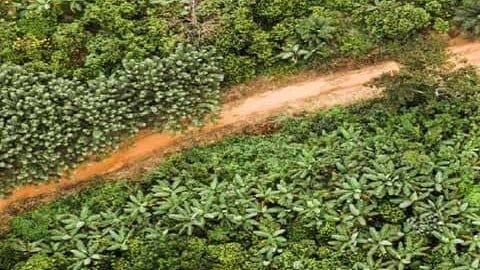Travel through our history timeline

Time travel through the Nestlé story
Come on a journey through Nestlé's company history. We'll begin in 1866 and finish in the present day.
Along the way, we'll see why Henri Nestlé created infant cereal, how the company weathered downturns and two world wars. We'll follow the acquisitions and the move into chocolate, pharmaceuticals and petcare. Before arriving here today, at the world's largest food and beverage company. Ready?
Explore our story below. Alternatively, you can download Nestlé company history timeline (pdf, 2Mb)
Period highlights

1866
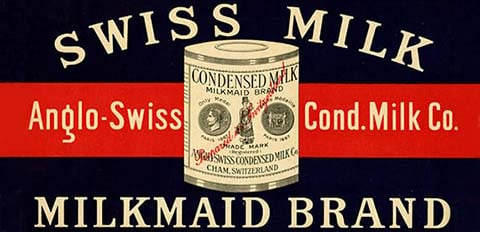
US brothers Charles and George Page establish the Anglo-Swiss Condensed Milk Company. Using the abundant supplies of fresh milk in Switzerland, they start Europe's first production facility for condensed milk. They sell the milk under the Milkmaid brand. It's marketed as a safe, long-life alternative to fresh milk.
1867
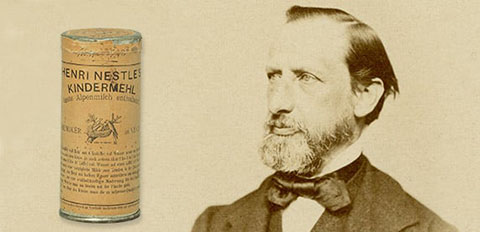
Nestlé's founder, German-born pharmacist Henri Nestlé, launches his 'farine lactée' ('flour with milk') in Vevey, Switzerland. Combining cow's milk, wheat flour and sugar, the product is designed for infants who can't be breastfed, to tackle high mortality rates. Around this time he starts using the iconic 'nest' logo.
1875

Henri Nestlé, now in his 60s, sells his company and factory in Vevey to three local businessmen. They employ chemists and skilled workers to help expand production and sales.
1878

Fierce competition develops between Nestlé and Anglo-Swiss. They are now selling rival versions of the other's original products: condensed milk and infant cereal. Both firms expand sales and production abroad.
1882-1902

In 1882 Anglo-Swiss moves into the US, but the death of founder George Page slows down plans. In 1902 Anglo-Swiss sells its US-based operations, paving the way for an eventual merger with Nestlé.
1904

Nestlé starts selling chocolate for the first time after taking over export sales for Peter & Kohler. In 1875, the Nestlé company also plays a role in developing milk chocolate by supplying Vevey neighbor, Daniel Peter, with condensed milk. Peter uses this in his trials to create the first milk chocolate to eat.
Period highlights
1905

Anglo-Swiss and Nestlé merge to form the Nestlé & Anglo-Swiss Milk Company. The company has two head offices in Vevey and Cham (Switzerland) and opens a third office in London to help drive export sales. Over several years the company expands its range to include unsweetened condensed milk and sterilized milk.
Period highlights

1914

War breaks out across Europe and disrupts production for the company. The hostilities also drive demand for Nestlé dairy products, in the form of large government contracts.
1915

Condensed milk is long-lasting and easy to transport, which makes it popular with armed forces. In 1915 the British Army starts giving Nestlé canned milk to soldiers in their emergency rations. Strong demand for this product means that the company's milk refineries are working flat out.
1916

Nestlé & Anglo-Swiss acquires Norwegian dairy company Egron. The business has patented a spray-drying process for producing milk powder, which Nestlé & Anglo-Swiss starts selling.
1917-1918

Milk shortages in Switzerland mean that Nestlé & Anglo-Swiss has to give its fresh milk supplies to help people in towns and cities. To meet the demand for condensed milk from the warring nations, the company buys US refineries and signs supply agreements with Australian companies, which it later acquires.
After the war, military demand for milk declines, causing a major crisis for Nestlé & Anglo-Swiss in 1921. The company recovers, but is rocked by the Wall Street Crash, which reduces consumer purchasing power. Despite the downs, the era delivers many positives. The company's management corps is professionalized, research is centralized and pioneering products like Nescafé coffee are launched.
Period highlights

1921-1922

In 1921, falling prices and high stock levels lead to the first, and only, financial loss for Nestlé & Anglo-Swiss. Banker Louis Dapples joins as crisis manager and encourages the company to appoint professional managers for the first time. Administration is centralized and all research is brought together at a laboratory in Vevey, Switzerland.
1929

The company buys Switzerland's largest chocolate company Peter-Cailler-Kohler, the origins of which date back to 1819 when François Louis Cailler created one of the country's first chocolate brands, Cailler. Chocolate now becomes a large part of the Nestlé & Anglo-Swiss business.
1934

Malted chocolate drink Milo launches in Australia, and is later exported to other markets. The company continues to develop baby and infant foods and introduces Pelargon in 1934. This is a full-milk powder for babies, enriched with lactic acid bacteria to improve digestibility.
1936
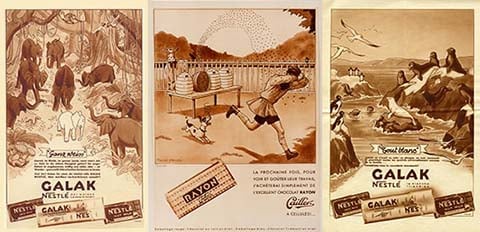
1936 sees Nestlé & Anglo-Swiss transformed into a holding company with a dual geographical structure (Nesthold in Vevey and Unilac in Panama). Nestlé launches the vitamin supplement Nestrovit and, the following year, the innovative products Galak white chocolate and Rayon, a chocolate with honey and air bubbles.
1938

Nescafé is launched as a 'powdered extract of pure coffee' that delivers coffee's natural flavor just by adding hot water. It's the brainchild of Max Morgenthaler, who created the product when the Brazilian government asked Nestlé & Anglo-Swiss to find an outlet for its huge coffee surplus.
The outbreak of World War Two in 1939 affects virtually every market. Nestlé & Anglo-Swiss continues to operate in difficult circumstances, supplying both civilians and armed forces. In 1947, the company adds Maggi soups and seasonings to its product range and adopts the name Nestlé Alimentana.
Period highlights
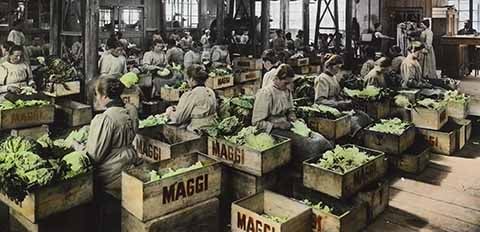
1939

Fearing that the Axis powers could occupy Switzerland, Nestlé & Anglo-Swiss relocates some managers to a new office in the US. This becomes the company's second headquarters during the war. The fighting makes it impossible for Nestlé to export milk from Europe, so the company supplies Africa and Asia from the US and Australia. It also expands into Latin America.
1942-1945

WWII initially slows sales of Nescafé, but they pick up as hostilities continue. When the US enters the war, Nestlé brands gain popularity among American service personnel. At the end of the war, Nescafé is included in CARE aid supplies in Japan and Europe. Following on from the success of instant coffee, Nestea is launched in the late 1940s.
1947

Nestlé & Anglo Swiss merges with Swiss company Alimentana, which produces Maggi soups, bouillons and seasonings. It's renamed Nestlé Alimentana. Alimentana's history dates back to 1884, when Julius Maggi developed a protein-rich dried soup to tackle malnutrition.
The post-war period is marked by growing prosperity. People in the US and Europe start spending money on machines that make life easier, like refrigerators and freezers. Convenience foods also become popular, with Nestlé Alimentana launching new products including Nesquik and Maggi ready meals.
Period highlights

1948

In the US, Nestlé Alimentana launches a soluble tea, Nestea. This is manufactured in the same way as Nescafé and can be served hot or cold. Nesquik, which dissolves easily in cold milk, is also launched in the US and becomes a top seller.
1954

Nestlé infant cereal has been around since 1948 as a powdered product, but it's now rebranded as Cerelac. In addition, Maggi's seasoning brand, Fondor, launches a powder alongside its original bouillon cube. Packaged in a convenient shaker, it can be used as a condiment in the dining room, as well as in the kitchen.
1957
Canned ravioli is launched under the Maggi brand. Its huge success prompts Nestlé to launch more canned, prepared foods. This becomes a new growth segment for the business.
Acquisitions enable Nestlé to enter new areas like frozen foods, while expanding its traditional businesses. In the 1970s the company diversifies into pharmaceuticals and cosmetics. Growing criticism from activist groups allege Nestlé's marketing of infant food is unethical. Nestlé later becomes one the first companies to apply the WHO code on breast-milk substitutes.
Period highlights
1960
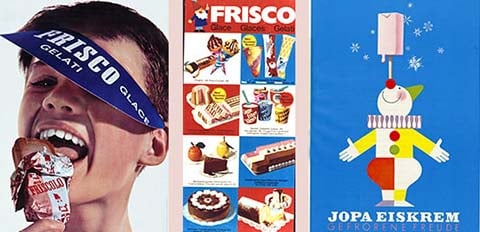
With more households buying freezers, demand for ice cream is rising. Nestlé buys German producer Jopa and French manufacturer Heudebert-Gervais to capitalize on this growth. It also adds Swiss brand Frisco to the mix in 1962. Nestlé brand acquisitions continue with the purchase of UK canned foods company Crosse & Blackwell.
1962
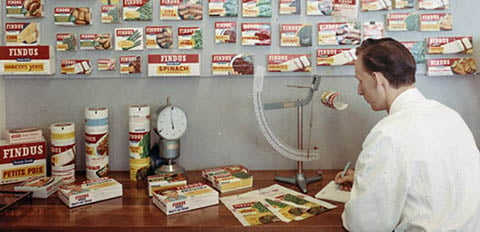
Nestlé buys the Findus frozen food brand from Swedish manufacturer Marabou, and takes the brand to international markets. In 1945, Findus becomes one of the first companies to sell frozen foods in Europe.
1968
As chilled dairy products are increasingly popular, Nestlé buys French yogurt producer Chambourcy. In the early 1970s Chambourcy launches the Sveltesse range of yogurts, aimed at health and weight-conscious consumers.
1969
To add to the acquisitions, Nestlé enters mineral waters by buying a stake in French water brand Vittel.
1973

Keen to bolster its canned foods and frozen portfolio in Anglo-Saxon markets, Nestlé takes over the US frozen foods company Stouffer Corporation. Three years later, it buys canned foods producer Libby, McNeill & Libby.
1974
For the first time in its history, Nestlé diversifies beyond food and drink. It becomes a minority shareholder in global cosmetics company L'Oréal.
1977
Renamed Nestlé S.A., the company continues its diversification strategy, buying US pharmaceutical and ophthalmic products manufacturer Alcon Laboratories. Declining breast-feeding rates lead some activists to question the baby food marketing strategies of companies like Nestlé. In 1977 they call on people to boycott Nestlé products.
After years of growth, Nestlé lets go of unprofitable brands. It starts promoting brands that meet the demands of more health-conscious consumers, in line with its new 'Nutrition, Health and Wellness' strategy. The company expands in the US, Eastern Europe and Asia, and targets for global leadership in water, ice cream and animal food.
Period highlights

1981
Stouffer's Lean Cuisine frozen meals are launched on a low-fat, low-calorie platform, which creates impressive sales. Nestlé and L'Oreal establish Galderma as a joint venture in dermatology. Plus, the World Health Assembly adopts the WHO code on breast-milk substitutes, which Nestlé applies across the business.
1985

By acquiring US-based Carnation Company for USD 3 billion, Nestlé adds brands such as Carnation and Coffee-Mate to its portfolio. It also enters the pet food business when it buys the Friskies brand.
1986

The Nespresso story begins with a simple idea: enable anyone to create a perfect cup of coffee, just like a skilled barista. People across Japan, Italy and Switzerland are given this opportunity in 1986 when Nespresso officially launches.
Read more: Calling coffee pilgrims everywhere! Nespresso
1988

Nestlé buys UK confectionery company Rowntree Mackintosh, adding brands like KitKat, After Eight and Smarties to its portfolio. It also acquires Italian pasta, sauce and confectionery group Buitoni-Perugina.
1991
Nestlé creates a joint venture with General Mills, Cereal Partners Worldwide, to produce and market breakfast cereals globally. The company also joins forces with The Coca-Cola Company to form Beverage Partners Worldwide. This paves the way for the manufacture and marketing of brands including Nestea.
1992

In 1992, Nestlé develops its position in mineral waters by acquiring France's Perrier Group. It goes on to create Nestlé Sources Internationales in 1993. This business is renamed Nestlé Waters in 2002.
Read more: How a Victorian exercise craze whipped Perrier into shape
1997
As the millennium approaches, Nestlé appoints a new CEO, Peter Brabeck-Letmathe. He sees growth potential in personalized nutrition and starts building Nestlé's position as the leader in 'Nutrition, Health and Wellness'.
1998

Following its acquisition of French water company Perrier, Nestlé now buys the Italian mineral waters business Sanpellegrino Group. It also launches Nestlé Pure Life in developing countries, to guarantee clean and healthy drinking water. Two years later Aquarel is introduced in Europe.
Nestlé articulates its Creating Shared Value approach to business. Followed by the launch of the Nestlé Cocoa Plan and Nescafé Plan to further develop sustainable supply chains. While the business continues strengthening its position in traditional segments like infant formula and frozen foods, it also starts focusing on medical nutrition.
Period highlights

2000

The Sustainable Agricultural Initiative Nestlé (SAIN) promotes collaboration with local farmers. It aims to improve living standards and ensure a more sustainable supply of commodities. In addition, Nestlé moves away from being primarily a processor of agricultural commodities to being a food producer and a key player in the areas of nutrition, health and wellness.
2001

Following the earlier acquisitions of Alpo Petfoods (1994) and Spillers Petfood (1998), Nestlé buys US pet food business Ralston Purina. The business merges this with Nestlé Friskies Petcare to become the new market leader, Nestlé Purina Petcare.
2002

After expanding its ice-cream business in the 1990s, Nestlé acquires the licensing rights to premium ice cream Häagen-Dazs in the US and Canada. The business also buys Mövenpick and Dreyer's Grand Ice Cream in 2003. Aside from the world of ice-cream, Nestlé acquires frozen foods business Chef America for USD 2.6 billion.
2006
Nestlé shares its Creating Shared Value approach to doing business. This states that any action for shareholders must also create value for local communities and wider society. Alongside this, Nestlé acquires weight management business Jenny Craig and Australian breakfast cereals company Uncle Toby's.
2007
A growing focus on medical nutrition leads Nestlé to acquire Novartis Medical Nutrition. It also buys baby food company Gerber, as well as Sources Minérales Henniez, a mineral water business in Switzerland. Nestlé's Board of Directors appoints Paul Bulcke, the current Head of Zone Americas, as CEO of Nestlé and Mr. Peter Brabeck-Letmathe as active, non-executive Chairman of the Board of Directors, effective April 2008.
2009

The first Creating Shared Value Forum in New York brings together experts to discuss global challenges in the areas of nutrition, water and rural development. As well as the role of businesses in helping to solve them. In this year Nestlé also creates its foodservice business division, Nestlé Professional.
2010
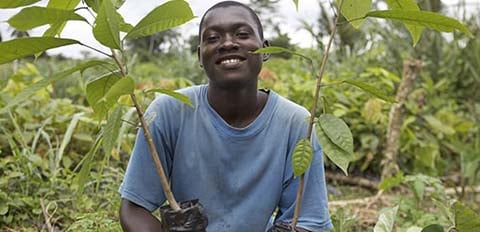
Nestlé acquires Kraft Foods' frozen pizza business. In addition, the Nestlé Cocoa Plan and Nescafé Plan are launched to develop the company's sustainable supply chains in cocoa and coffee. The plans aim to improve social conditions in farming communities, while ensuring their profitability.
2011

The business establishes Nestlé Health Science and the Nestlé Institute of Health Sciences. The aim? To research science-based nutritional products aimed at preventing and treating chronic medical conditions. What's more, Nestlé becomes the first food company to work with the Fair Labor Association (FLA), to help tackle child labor in the cocoa supply chain.
2012
In a bid to strengthen its position in infant nutrition, Nestlé acquires Wyeth Nutrition, formerly Pfizer Nutrition, for USD 11.9 billion.
2013
Nestlé Health Science buys US-based medical foods company Pamlab, which specializes in medical nutrition for patients with conditions including mild cognitive impairment and depression. Weight management business, Jenny Craig, is sold in America and Oceania. While Nestlé needs YOUth is launched with the aim of combating widespread youth unemployment.
2014

With the creation of Nestlé Skin Health, Nestlé takes full control of the Galderma dermatology joint venture which it developed with L'Oréal in 1981. The companies also end their joint venture Innéov, a cosmetic nutritional supplements business launched in 2002. Galderma subsequently acquires some of its assets.
2016

Nestlé celebrates its 150th year as a company. It also incorporates a portion of its ice cream, frozen food and chilled dairy business into a joint venture - Froneri - with UK ice cream manufacturer R+R.
Alongside traditional market segments, Nestlé continues to find new growth opportunities in healthcare. It acquires businesses including Zenpep, Vital Proteins and Aimmune, plus a majority stake in Orgain, a leader in plant-based nutrition. The company also steps up its sustainability aims, committing to recyclable packaging and net zero emissions.
Period highlights

2017
Under the new CEO Mark Schneider and Chairman Paul Bulcke, Nestlé acquires Atrium Innovations. A move which supports Nestlé's development in consumer healthcare, while complementing the focus on high-growth categories like coffee, petcare, infant nutrition and plant-based products. US investments are made in Blue Bottle Coffee, Sweet Earth and Freshly.
2018

Nestlé acquires dog nutrition business Tails.com. It's also granted the rights to market Starbucks products globally, outside of the company's coffee shops. This gives Nestlé a platform for growth in North America and worldwide. In addition, the business sets out the ambition to make 100% of its packaging recyclable or reusable.
2019

Nestlé inaugurates the Nestlé Institute of Packaging Sciences, closes the sale of Nestlé Skin Health, and sells 60% of its stake in Herta to create a joint venture with Casa Tarradellas. It also sells its U.S. ice cream business to its Joint Venture Froneri. Internally, the business supports families with a new and enhanced parental leave policy.
2020

Nestlé Health Science expands its portfolio through the acquisition of Zenpep, Vital Proteins and Aimmune. While the Yinlu peanut milk and canned rice porridge businesses are sold. Nestlé also launches its Net Zero Roadmap, which outlines the company's commitment to achieve net zero emissions by 2050 at the latest.
2021

The business sells Nestlé Waters North America brands and acquires functional hydration brands Essentia and Nuun. In the same year, Nestlé reduces its stake in L'Oréal, while Nestlé Health Science boosts its portfolio through the part acquisition of The Bountiful Company. 'Generation Regeneration' is launched and Nestlé publishes its climate roadmap.
2022
Nestlé kicks off the year by announcing further plans to tackle child labor risk. Shortly followed by the creation of the Nestlé Institute of Agricultural Sciences, which aims to strengthen the business's agricultural science expertise. The company also achieves its carbon peak. Meanwhile, Nestlé Health Science acquires a majority stake in Orgain, a leader in plant-based nutrition.







